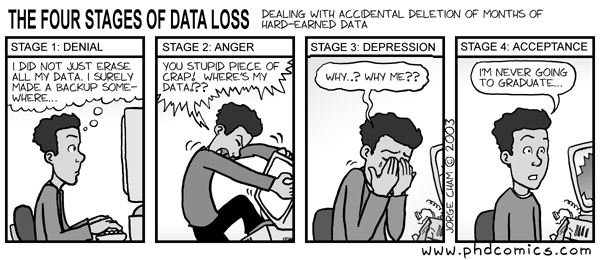
How you choose to store and secure your data makes a significant impact on whether it will truly be available when needed in the future. You must keep in mind the formats your data are stored in, the devices and locations in which they are stored, as well as methods for keeping your data secure, which may include anonymization of data, encryption, and physical security.
For an in-depth look into topics of data storage and security, explore the UK Data Service's guide.
Quick tips:
Data security includes three aspects:
1. Physical security involves controlling access to buildings or rooms where your data is held. This may be as simple as ensuring that the lab where your workstation is located is locked, with key card access only granted to you and your lab personnel.
2. Network security includes firewall protection and ensuring that patches to your computer's operation systems are regularly updated to avoid security holes.
3. Device & file security involves everything from password-protecting your devices to anonymizing sensitive data.
It may be worthwhile to check out Simmons' Information Security Policy.

Don't be this fellow. Back up your work. Best practice is to have 3 copies:
Here - local/working copy on your device
Near - other local or external copy (such as an external hard drive)
Far - remote copy (a secure option in the cloud)
For example you could have copies in:
The University Archives is available to provide guidance on the legal requirements for retaining and destroying other records of the research process. Visit https://www.simmons.edu/
Remember that the accessibility of your data depends on both the quality of the storage media and the availability of appropriate data-reading equipment. As explained in the UK Data Service's guide on data storage: "an Amstrad floppy disc may still work perfectly 20 years after it was made, but the lack of working machines means that the data on this disc may not be easily recoverable."
File formats are just as susceptible to obsolescence as physical media. Use recommended formats to ensure that your data is accessible.
For more information see: